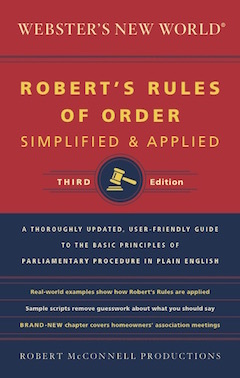The proper form of HOA minutes
By Robert McConnell Productions
There are many misconceptions about what should go into the minutes and often the president or the secretary or perhaps another member tries to put his own spin on the minutes. This is not permissible. Minutes are the legal record of what action was taken at a meeting. Usually remarks and debate are not entered in to the minutes. Sometimes a reason for some action may need to be included in the minutes so that it will make sense to people reading the minutes at a later time.
Here is what must go into the minutes:
The first paragraph includes the type of the meeting: regular, special or adjourned.
It includes the name of the HOA
The date, the time, the place, and who called the meeting to order—the president or another person.
It also states whether the secretary was present or someone else took the minutes
The last statement of the paragraph states whether the minutes of the previous meeting was approved as read or corrected.
The minutes should follow the order of the agenda. The generally accepted order of an agenda is
Reading and Approval of the minutes
Reports of Officers, Boards and Standing Committees
Reports of Special Committees
Special Orders
Unfinished Business and General Orders
New Business
Not all of these topics will be on the agenda at every meeting and sometimes members have things like correspondence, announcements or a program. In any event each topic on the agenda has a new paragraph.
Reports
The minutes should state what reports were given and a brief summary of each report. If the report is written, and of great importance, it can be attached to the minutes. Usually every meeting there is a Treasurer’s Report. If it is complicated it can be attached to the minutes and just beginning and ending balances given and also the total expenditures and income for the month of the quarter. The HOA should decide what is best for them.
Main motions are the way business is presented at both board meetings and the annual meeting. Under the Agenda topic a main motion is made, the motion is recorded. The minutes should state the name of the maker of the motion, the motion as presented, and whether it was debated. Often times other members present amendments to this motion. The best practice is just to include the amendments that were adopted. Usually it can be done very simply by stating the motion was amended, and then state the finally wording of the amended motion and if it was adopted or defeated.
Sometimes motions are postponed to the next meeting or referred to a committee. In that case the minutes would state, “Jack moved to …The motion was postponed to the next meeting.” Or “the motion was referred to the Finance Committee to report back at the next meeting.”
If a motion is adopted, it is important to put in the minutes the person or committee that is to carry out the motion. That way if it is not done, the board can find out why it was not done. There is a record of accountability.
The minutes also include notice of all motions that will be taken up at the next meeting; points of order and appeals from the decision of the chair, and the time the meeting was adjourned.
After the secretary writes the minutes, he or she should sign his name at the end of the minutes. There is no need to say “respectfully submitted.” When the minutes are approved at the next meeting, the secretary should initial the minutes and write approved as “read” or “corrected” and the date.
For more information about writing minutes, see Robert’s Rules of Order Simplified and Applied, and McMinutes a Training Manual for Secretaries.
